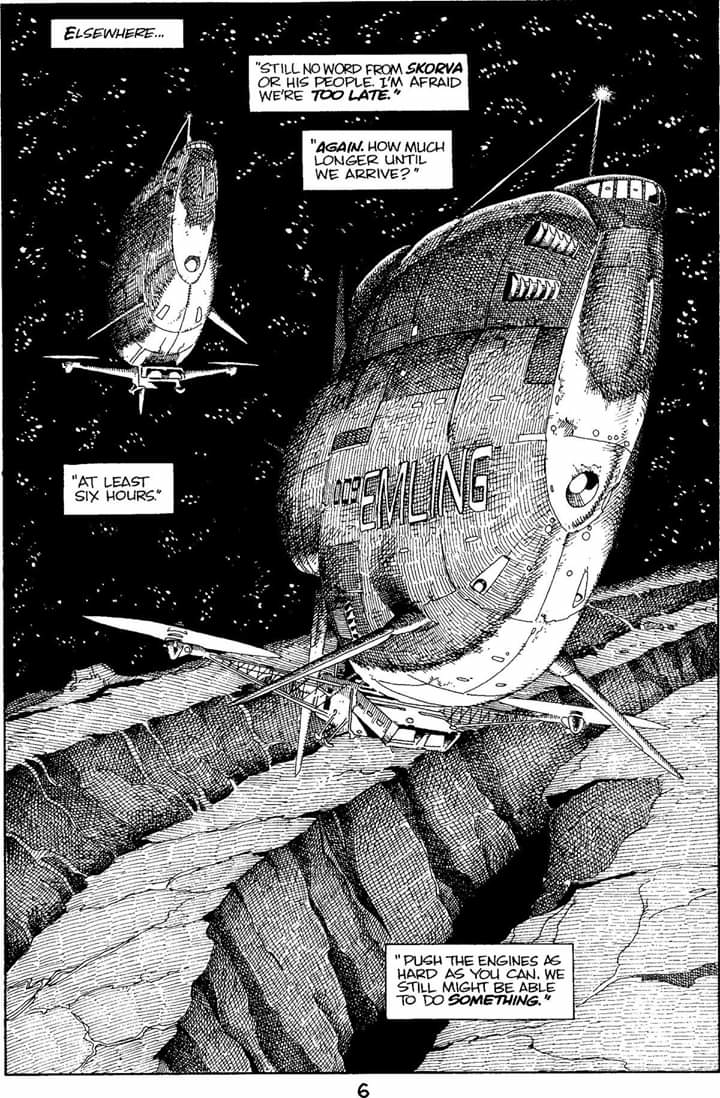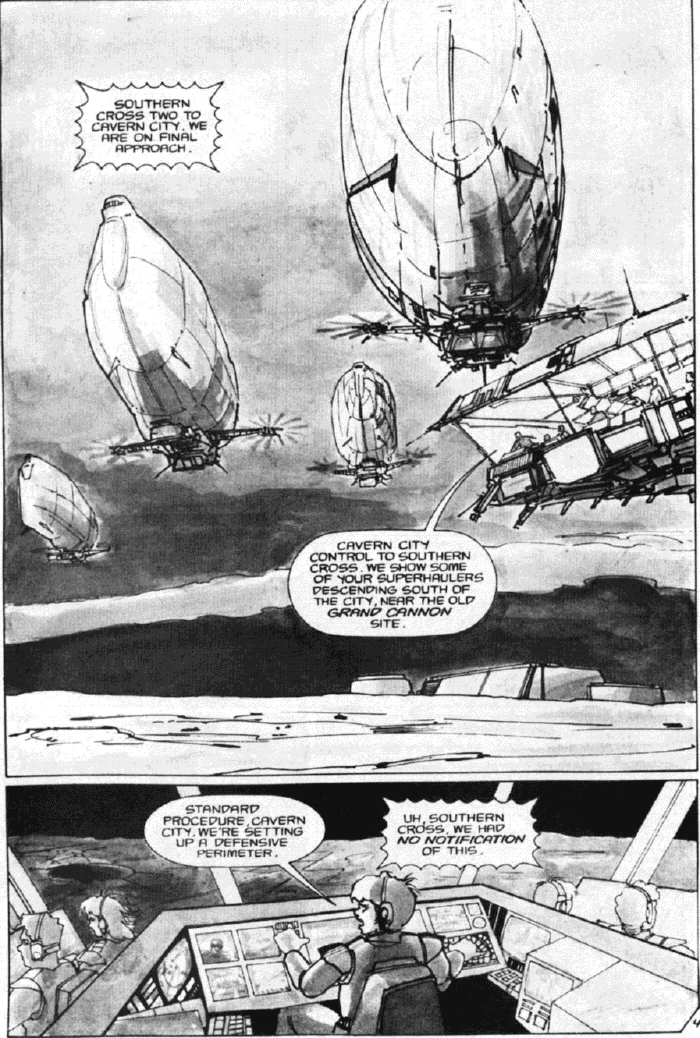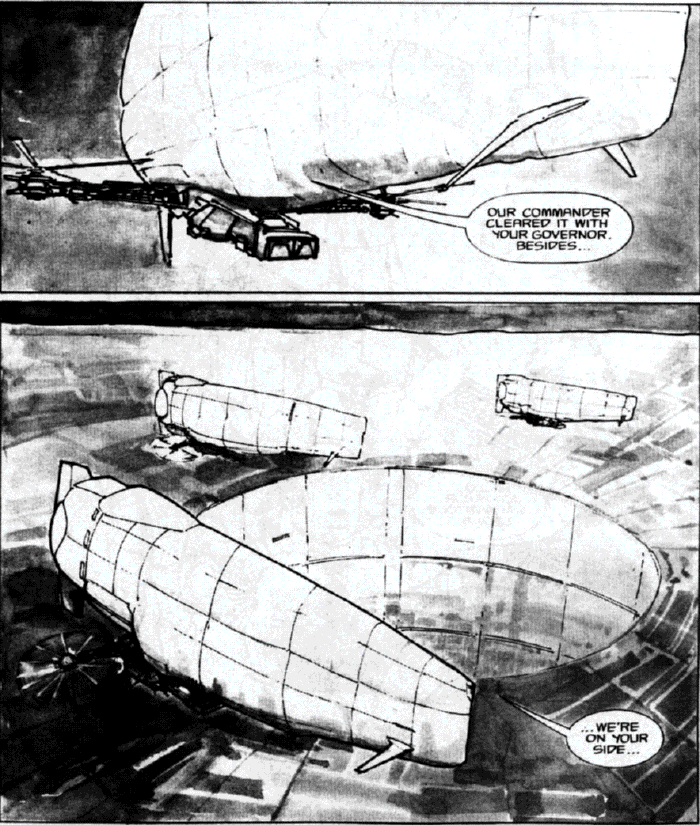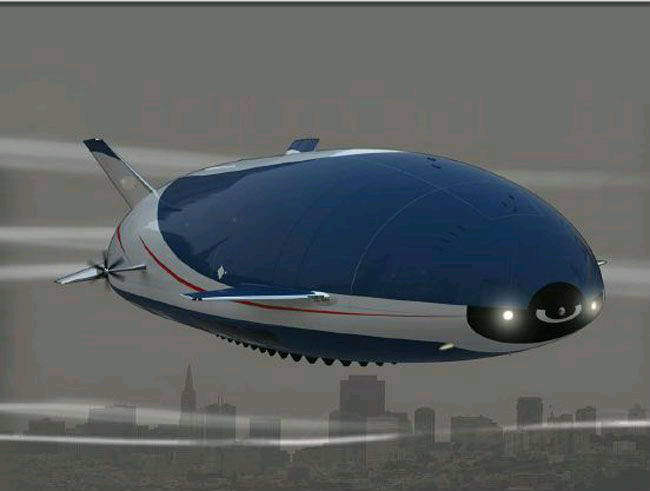「サザンクロス軍・二番機よりカーヴァン市へ。我々は進入経路に最終接近(ファイナル・アプローチ)中である!」 
従来型飛行船は運行費が安いが、大きさの割に積載重量が少なく、低い運行速度などの欠点がある。
加えて飛行船の地上取り扱いの難しさは致命的で、純粋な "LTA飛行船" が着陸進入するときは中立浮遊であり、風の影響を受けやすい。
- ◆ Lighter Than Air/LTA:「空気より軽い航空機」の意味。
僅かな微風でさえ、係留柱に固定するためには係留車と大勢の地上職員が必要になり、地上業務には大きな危険を伴うこともあった。
重航空機は飛行船が持つ欠点を克服する一方、揚力を発生するために高い出力を持つ動力を必要とし、滑走路も必要とする。
ハイブリッド飛行船は、取扱い困難な在来型飛行船と高速だが運行維持費の高い重航空機との中間を埋めることを目的として開発され、揚力と浮力を組み合わせることで、他の手段では成し得ない航空積載量の実現を期待し開発が進められている。
サザンクロス軍では、陸軍航空輸送部に所属し、地球統合陸軍より引き継いだデストロイドの他、VHT-1「セントール」や、VHT-2 スパルタス等を空輸したほか、航空宇宙局でも少数が輜重(いちょう)/兵站(へいたん)部にて後方輸送に使用された。
| 複合型飛行船 ⇒ 機体内部に充填された比重が軽い気体の浮力と、 動力で発生させる揚力との組合せによって浮揚する飛行船。 気体の比重のみで浮上可能な従来の飛行船(軽飛行船)と区別するため、重飛行船とも呼ばれる。 代表的な試作機として、 パイアセッキ PA-97 ヘリシュタット/ Piasecki PA-97 Helistatなどがある。 |  |
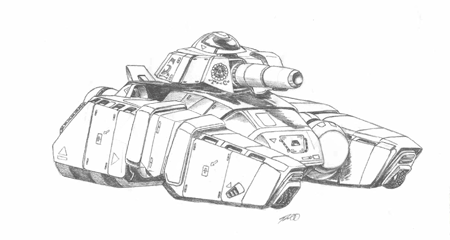 | 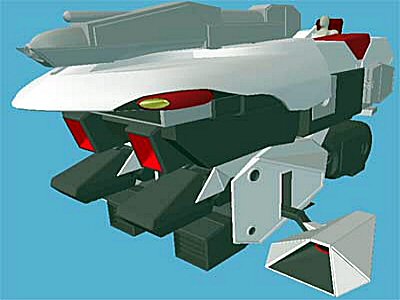 |
| VHT-1「セントール」(-1A1, -1A1, -1A2) | VHT-2A1 スパルタス(-2, -2A1, -2A2) |
非武装かつ、軽航空機類である「飛行船」と同様に、防弾が困難で対空火器に弱い為、航空制圧で制空権を確保した地域で無ければ活動出来ず、前線に近い場所への輸送には難があった。
とはいえ、重力制御により浮揚する、サザンクロス軍の宇宙艦艇の大気・重力圏下での使用は、膨大なプロトカルチャー (資源)のエネルギー消費を必要としたので、経済的観点からは利点もあった。
| ★大気・重力圏下で使用された、サザンクロス軍の宇宙艦艇 |
| ・トリスター級・超時空重巡洋艦(SCB/SBH) |
| ・バンシー級・超時空駆逐艦(SDD/SDG) |
| ・ジュネーヴ級・超時空軽巡洋艦(SCG/SCA) |
サザンクロス軍の総司令アナトール・エリ・レオナルドは陸軍の出身で、西暦2003年〜同2009年に掛けて進行したデストロイド開発計画、プロジェクト・エクスキャリヴァーを統合宇宙軍/空軍/海兵隊の推進したプロジェクト・バルキリーにより阻害され、予算を持っていかれたとの私怨があったと推察される。
この為、部隊の輸送機/輸送船を統合軍の空軍/海軍に依頼する事を拒み、サザンクロス軍独自に本記事の NT.1000「フェルディナンド」ヘリスタット超重・貨物輸送船 や「VC-150 フォティナス 重貨物輸送艇」を強制徴発した。
という運用上の問題点をそれぞれ抱えていた。
この為、部隊の輸送機/輸送船を統合軍の空軍/海軍に依頼する事を拒み、サザンクロス軍独自に本記事の NT.1000「フェルディナンド」ヘリスタット超重・貨物輸送船 や「VC-150 フォティナス 重貨物輸送艇」を強制徴発した。
- 本記事の飛行船『NT.1000 フェルディナンド』は輸送力は充分なものの、脆弱性の為に"前線近くまでは"デストロイド/VHT-1 セントール/VHT-2 スパルタスを輸送出来ず、
- 「VC-150 フォティナス 重貨物輸送艇」は、装甲をある程度備えていたが、半面で4,000フィート(1219.2 m)の"最大"飛行上昇限界は*1 悪天候でも雲上に上がれず、迂回するか、雲を突っ切るしかない。
という運用上の問題点をそれぞれ抱えていた。
| 記号 | NT.1000 |
| 名称 | フェルディナンド |
| 全長 | LZ127と同程度 |
| 直径 | LZ127より大 |
| 容量 | LZ127より大 |
| 動力 | 不明、LZ127より大 |
| 速度 | 80mph(128km/h) |
| 上昇限界 | 30,000 ft.(9,144m) |
| 航続距離 | 4,000 mile(6,400km) |
| 搭載量 | 90.0t |
| 記号 | LZ127 |
| 名称 | Graf Zeppelin |
| 全長 | 236.6m |
| 直径 | 30.5m |
| 容量 | 105,000 m3 |
| 動力 | マイバッハVL2 水冷V型12気筒 550馬力×5基 |
| 速度 | 110km/h |
| 上昇限界 | 約2,500m |
| 航続距離 | 10,000km〜15,000km |
| 搭載量 | 60.0t |
NT.1000は、統合戦争の戦後時代の技術復興(ルネッサンス)の開発だった。
皮肉なことに、それは統合戦争が始まる前、数十年以上も前に殆んど放棄された「空気より軽い航空機の技術領域」【folder】の発展を表している。
NT.1000 ヘリシュタット【Helistat】は貨物積載能力を高める為にヘリコプターの技術を利用した金属製・硬式/剛性構造飛行船である。
飛行船は、20世紀のLZ127 グラーフ・ツェッペリン【GrafZeppelin】とほぼ同じ全長で、全幅と全高でそれより遥かに大きい。
NT.1000 の外皮は実質的に歩兵規模の小火器の発砲に難攻不落であり、軽・対車両火器に耐性になる薄い装甲外皮である。
この装甲外皮下にヘリウム浮揚ガス袋(気嚢)が囲む軽量複合構造がある。
上部と飛行船の側面に沿って大気から水を凝集する為のコンデンサー、姿勢微調整の為の小型釣り合いタンク線下の内部に浮力を発生する気嚢(きのう)が位置する。
この水は、飛行船の下部の複数の排出孔より船外に排出可能。
▼ヘリウムガスは高価な為に、ガス排出に代えて、水を凝集することで、重量を増やし下降用の錘とする。緩やかな下降の場合にしか使えないが、ガス排出や、回転翼(ローター)の羽根角変更や逆転による強制下降より経済的である。
浮揚気嚢の下に目を移すと、下部気嚢の中に延びるのはゴンドラ貨物倉と機関区画である。
このゴンドラの両側に推進力と追加揚力の両方を提供するヘリコプターシステムの側面の左右双子配置の回転翼(ローター)がある。
20世紀の飛行船とは異なり、NT.1000 の艦橋(ブリッジ)は浮揚気嚢(きのう)の先端部である船首に位置している。
艦橋は軽量であり、その竜骨(キール)に沿って、飛行船の中心を通って通路で機関室区画上の乗組員容積に接続されている。
NT.1000の貨物倉は、最大90トンの貨物を運び、複数の第1世代デストロイドを収容するのに十分な容積を持つ。
貨物倉の前方に展開・収納が自在な傾斜式の車輛搬入出板(ランプ)が簡単に接続可能である。
NT.1000は、調理室、シャワー設備、小型休憩室(小ラウンジ)、複数段形式の睡眠宿舎を含め20人までの乗組員生活容積を持っている。
旅客船として敢えて就役させたならば、初期状況であるが、数百人の乗客を飛行船の大貨物室に収容可能である。
飛行船システムと回転翼の為の動力はフレックス式燃料電池で提供され、それはどんな炭化水素、またはSLMHでさえ作動可能である。
動力システムの燃料タンクは、釣り合い(バラスト)タンクと共に点在収容され自動防漏されると共に、安全の為に装甲が施されている。
回転翼システムが飛行船に80mph(128km/h)の最高速度、30,000フィート(9,144m)の上昇限界、4,000マイル(6,400km)の航続距離を提供し、SLMHを使用した場合はこの値はおよそ倍になる。
回転翼システムは飛行船の浮揚ガスの垂直離着陸能力を支援し、羽根角度や回転周期の正確な制御を行うならば、回転翼ポッドの角度調整をも制御に用いて、飛行船は「所定位置にて旋回」(履帯車輛で云う超信地旋回)可能で、「後進飛行」や「横方向飛行さえ可能」だが、特に後者は最大速度の僅か10分の1の速度割合になる。
NT.1000 は完全に非武装であるが、衛星アップリンク機能を備えた無線システム(有効通信距離300マイル/482.7km.)の追加で、航法レーダーシステム(捜索範囲50マイル/80.45km.)と可動式ターレットのビデオカメラを備え、自動操縦装置は航法コンピューターが利用可能な有効GPS、無線測位、または地形照合により自機の現在位置を決定し、進路をプロットする。
NT.1000は、米国とブラジルの企業からライセンスを取得し、ドイツで製造設備の建設と飛行船の建造を行った。
それは空港に専門支援設備が必要とされ、貨物機よりも遥かに遅かったが、その航続距離、貨物倉の規模、重貨物を運搬する能力により、NT.1000は、統合戦争が終わった後の時間で貴重な道具を形成した。
NT.1000達の多数が地球統合政府のマクロス島のための支援努力とSDF-1の復興の主要な部分であり、国際貿易に対する、公衆には比較的未知の屋台骨となった
多くはゼントラーディ基幹艦隊の「死の雨」を生き残って、至る地域にて価値ある道具になった。
特に注目に値した NT.1000 の使用は、発展しかけのサザンクロス軍の陸軍に対する、その組織にただでさえ欠如していた機動性を提供する、部隊輸送と補給物資輸送船としての超・運送屋(スーパー・ホットロッド)任務だった。
NT.1000 は2020年代に入って以降も就役を継続し、さらに使用されている最も一般的な民間貨物機の一つとなって、復興時に低率の生産を見た。
2031年にインビッドの到着後、NT.1000は主にそれらの非戦闘性質と非プロトカルチャー (資源)動力源に起因するインビッドの無視により、人類社会では引き続き採用され続けた。
入手し易い水素浮揚ガスを使う為に大抵が改装された複数の NT.1000 は、取引や投機の対象にすらなり、場合によっては星間大戦の戦前のジプシーのものに類似した共同体の放浪や隊商(ファクトリー)の移動住居にすらなった。
レジスタンス達は長大な航続距離、VTOL能力、そしてインビッドのセンサーに比較的不可視な為に NT.1000を愛した。
或るレジスタンス分子は機動兵器のその供給を犠牲にすることなく強大な機動性を獲得した1隻の独自改造された NT.1000 を以て、一般民間船として、簡単にインビッドの検問を通過することが出来た。
飛行船の脆弱な性質により抵抗グループは、滅多に NT.1000 を武装化せず、代わりに偽装するか、防衛の為の戦闘人員を乗船させる措置に頼った。
皮肉なことに、それは統合戦争が始まる前、数十年以上も前に殆んど放棄された「空気より軽い航空機の技術領域」【folder】の発展を表している。
NT.1000 ヘリシュタット【Helistat】は貨物積載能力を高める為にヘリコプターの技術を利用した金属製・硬式/剛性構造飛行船である。
飛行船は、20世紀のLZ127 グラーフ・ツェッペリン【GrafZeppelin】とほぼ同じ全長で、全幅と全高でそれより遥かに大きい。
NT.1000 の外皮は実質的に歩兵規模の小火器の発砲に難攻不落であり、軽・対車両火器に耐性になる薄い装甲外皮である。
この装甲外皮下にヘリウム浮揚ガス袋(気嚢)が囲む軽量複合構造がある。
上部と飛行船の側面に沿って大気から水を凝集する為のコンデンサー、姿勢微調整の為の小型釣り合いタンク線下の内部に浮力を発生する気嚢(きのう)が位置する。
この水は、飛行船の下部の複数の排出孔より船外に排出可能。
▼ヘリウムガスは高価な為に、ガス排出に代えて、水を凝集することで、重量を増やし下降用の錘とする。緩やかな下降の場合にしか使えないが、ガス排出や、回転翼(ローター)の羽根角変更や逆転による強制下降より経済的である。
浮揚気嚢の下に目を移すと、下部気嚢の中に延びるのはゴンドラ貨物倉と機関区画である。
このゴンドラの両側に推進力と追加揚力の両方を提供するヘリコプターシステムの側面の左右双子配置の回転翼(ローター)がある。
20世紀の飛行船とは異なり、NT.1000 の艦橋(ブリッジ)は浮揚気嚢(きのう)の先端部である船首に位置している。
艦橋は軽量であり、その竜骨(キール)に沿って、飛行船の中心を通って通路で機関室区画上の乗組員容積に接続されている。
NT.1000の貨物倉は、最大90トンの貨物を運び、複数の第1世代デストロイドを収容するのに十分な容積を持つ。
貨物倉の前方に展開・収納が自在な傾斜式の車輛搬入出板(ランプ)が簡単に接続可能である。
NT.1000は、調理室、シャワー設備、小型休憩室(小ラウンジ)、複数段形式の睡眠宿舎を含め20人までの乗組員生活容積を持っている。
旅客船として敢えて就役させたならば、初期状況であるが、数百人の乗客を飛行船の大貨物室に収容可能である。
飛行船システムと回転翼の為の動力はフレックス式燃料電池で提供され、それはどんな炭化水素、またはSLMHでさえ作動可能である。
- 「安定化・液体金属水素」【Stabilized Liquid Metallic Hydrogen (SLMH) 】〔 金属水素 - Wikipedia 〕
動力システムの燃料タンクは、釣り合い(バラスト)タンクと共に点在収容され自動防漏されると共に、安全の為に装甲が施されている。
回転翼システムが飛行船に80mph(128km/h)の最高速度、30,000フィート(9,144m)の上昇限界、4,000マイル(6,400km)の航続距離を提供し、SLMHを使用した場合はこの値はおよそ倍になる。
回転翼システムは飛行船の浮揚ガスの垂直離着陸能力を支援し、羽根角度や回転周期の正確な制御を行うならば、回転翼ポッドの角度調整をも制御に用いて、飛行船は「所定位置にて旋回」(履帯車輛で云う超信地旋回)可能で、「後進飛行」や「横方向飛行さえ可能」だが、特に後者は最大速度の僅か10分の1の速度割合になる。
NT.1000 は完全に非武装であるが、衛星アップリンク機能を備えた無線システム(有効通信距離300マイル/482.7km.)の追加で、航法レーダーシステム(捜索範囲50マイル/80.45km.)と可動式ターレットのビデオカメラを備え、自動操縦装置は航法コンピューターが利用可能な有効GPS、無線測位、または地形照合により自機の現在位置を決定し、進路をプロットする。
- ★ アップリンク:地上海上、上空の端末機から、測地人工衛星へのデータ信号の送信作業。
- ◎ GPS, 全地球測位システム
- ※ プロット:(海図などに)船・飛行機などの位置を記入する作業。
NT.1000は、米国とブラジルの企業からライセンスを取得し、ドイツで製造設備の建設と飛行船の建造を行った。
それは空港に専門支援設備が必要とされ、貨物機よりも遥かに遅かったが、その航続距離、貨物倉の規模、重貨物を運搬する能力により、NT.1000は、統合戦争が終わった後の時間で貴重な道具を形成した。
NT.1000達の多数が地球統合政府のマクロス島のための支援努力とSDF-1の復興の主要な部分であり、国際貿易に対する、公衆には比較的未知の屋台骨となった
多くはゼントラーディ基幹艦隊の「死の雨」を生き残って、至る地域にて価値ある道具になった。
特に注目に値した NT.1000 の使用は、発展しかけのサザンクロス軍の陸軍に対する、その組織にただでさえ欠如していた機動性を提供する、部隊輸送と補給物資輸送船としての超・運送屋(スーパー・ホットロッド)任務だった。
NT.1000 は2020年代に入って以降も就役を継続し、さらに使用されている最も一般的な民間貨物機の一つとなって、復興時に低率の生産を見た。
2031年にインビッドの到着後、NT.1000は主にそれらの非戦闘性質と非プロトカルチャー (資源)動力源に起因するインビッドの無視により、人類社会では引き続き採用され続けた。
入手し易い水素浮揚ガスを使う為に大抵が改装された複数の NT.1000 は、取引や投機の対象にすらなり、場合によっては星間大戦の戦前のジプシーのものに類似した共同体の放浪や隊商(ファクトリー)の移動住居にすらなった。
レジスタンス達は長大な航続距離、VTOL能力、そしてインビッドのセンサーに比較的不可視な為に NT.1000を愛した。
或るレジスタンス分子は機動兵器のその供給を犠牲にすることなく強大な機動性を獲得した1隻の独自改造された NT.1000 を以て、一般民間船として、簡単にインビッドの検問を通過することが出来た。
飛行船の脆弱な性質により抵抗グループは、滅多に NT.1000 を武装化せず、代わりに偽装するか、防衛の為の戦闘人員を乗船させる措置に頼った。
The NT.1000 was a development of the post globalwar era technological renaissance.
Ironically, it represents a development of folder lighter than airtechnology largely abandoned decades before the global war started.
The NT.1000 Helistat is a metal-clad rigid airship that also makes use of helicopter technology to enhance its cargolift capacity.
The airship is large, nearly the same length as the 20th century's LZ127 GrafZeppelin, and far larger in width and height.
The NT.1000's outer skin is a thin armored skin that makes it practically invulnerable to infantry scale weapons fire, and resistant tolight anti vehicle weapons.
Beneath this armored skin is the light weight composite airframe,which surrounds the Helium lift gas cells.
Along the top and sides of the airship are condensers for gathering water from the air, and small ballast tanks line the interior of the lower envelope for fine tuning the buoyancy.
This water can be ejected out multiple ports along the bottom of the airship.
Slung beneath the lifting envelope is a gondola cargo bay and engineering module, which extends into the lower envelope. on either side of this gondola are the twin rotors of the helicopter system, which provide both propulsion and additional lift.
Unlike airships from the 20th century, the NT.1000's bridge is located at the top prow of the lift envelope.
The bridge is light weight and connected to the crew spaces above the engineering module by a walkway through the center of the airship, along its keel.
The NT.1000's cargo bay can carry 90 tons of cargo, and is large enoughto house multiple 1st generation destroids.
An extendable ramp at the front of the bay allows easy access.
The NT.1000 has crew spaces for up to 20 people,including a kitchen, shower facilities, a small lounge, and bunk style sleeping quarters.
If pressed into service as a passenger vessel, several hundred people can be housed in the airships large cargo bay, albeit in primitive conditions.
Power for the vessels systems and rotors is provided by a flex-fuel fuel cell,which is capable of running on any hydrocarbon or even SLMH.
Fuel tanks for thepower system are housed interspersed with the ballast tanks, are self sealing,and armored for safety.
The rotor system gives the airship a top speed of 80mph/128kmh, a ceiling of 30,000 feet (9144 meters), and a range of 4000 miles(6400 km), double that using SLMH.
The rotor system enhances its vertical take-off and landing capability by allowing it to be precisely controlled, and using the rotors the airship can spin in place and fly backwards or even sideways,the latter at only a tenth of the top speed however.
The NT.1000 is completely unarmed, although it does have a radar system (range 50 miles) and turreted video cameras for navigation, in additional to a radio system (300 miles) with satellite uplink capability, and an auto pilot enabled navigation computer able to use GPS, radio positioning, or terrain matching to determine its location and plot a course.
The NT.1000 was produced in Germany,with licensed construction from firms in the United States and Brazil.
Although it was far slower than cargo aircraft and required specialized support systems at airports, its range, the size of its cargobay, and ability to haul heavy loads made the NT.1000 a valuable tool in the time after the Global war ended.
NT.1000's were a major part of the UEG's support efforts for Macross Island and the reconstruction of the SDF-1, and became a relatively unknown backbone to international trade.
Many survived the Zentraedi 'Rain of Death', and became a valuable tool in there construction.
Of particular note was the use of NT.1000 super haulers by thenascent "Army of the Southern Cross" as troop transports and supply haulers, which provided that organization a mobility it otherwise lacked.
The NT.1000 continued in service well into the 2020's, and even saw low rate production during the reconstruction, making it one of the most common civilian cargo aircraft in use.
After the arrival of the Invid in 2031, the NT.1000 continued to be employed, largely ignored by the Invid due to their non-combat nature and non-protoculture power plants.
Usually refitted to use hydrogen lift gas, NT.1000's became vectors for trade, in some cases even became homes to roving communities similar to the Gypsy's before the first robotech wars.
The resistance too loved the NT.1000 due to its long range, VTOL ability, and relative invisibility to Invid sensors.
A resistance cell with an NT.1000 had massive mobility without sacrificing its supply of mecha, and could easily pass as a civilian vessel.
Resistance groups rarely armed their NT.1000's, due to the fragile nature of the airship, instead relying on disguise or embarked combatants for defense.
Ironically, it represents a development of folder lighter than airtechnology largely abandoned decades before the global war started.
The NT.1000 Helistat is a metal-clad rigid airship that also makes use of helicopter technology to enhance its cargolift capacity.
The airship is large, nearly the same length as the 20th century's LZ127 GrafZeppelin, and far larger in width and height.
The NT.1000's outer skin is a thin armored skin that makes it practically invulnerable to infantry scale weapons fire, and resistant tolight anti vehicle weapons.
Beneath this armored skin is the light weight composite airframe,which surrounds the Helium lift gas cells.
Along the top and sides of the airship are condensers for gathering water from the air, and small ballast tanks line the interior of the lower envelope for fine tuning the buoyancy.
This water can be ejected out multiple ports along the bottom of the airship.
Slung beneath the lifting envelope is a gondola cargo bay and engineering module, which extends into the lower envelope. on either side of this gondola are the twin rotors of the helicopter system, which provide both propulsion and additional lift.
Unlike airships from the 20th century, the NT.1000's bridge is located at the top prow of the lift envelope.
The bridge is light weight and connected to the crew spaces above the engineering module by a walkway through the center of the airship, along its keel.
The NT.1000's cargo bay can carry 90 tons of cargo, and is large enoughto house multiple 1st generation destroids.
An extendable ramp at the front of the bay allows easy access.
The NT.1000 has crew spaces for up to 20 people,including a kitchen, shower facilities, a small lounge, and bunk style sleeping quarters.
If pressed into service as a passenger vessel, several hundred people can be housed in the airships large cargo bay, albeit in primitive conditions.
Power for the vessels systems and rotors is provided by a flex-fuel fuel cell,which is capable of running on any hydrocarbon or even SLMH.
Fuel tanks for thepower system are housed interspersed with the ballast tanks, are self sealing,and armored for safety.
The rotor system gives the airship a top speed of 80mph/128kmh, a ceiling of 30,000 feet (9144 meters), and a range of 4000 miles(6400 km), double that using SLMH.
The rotor system enhances its vertical take-off and landing capability by allowing it to be precisely controlled, and using the rotors the airship can spin in place and fly backwards or even sideways,the latter at only a tenth of the top speed however.
The NT.1000 is completely unarmed, although it does have a radar system (range 50 miles) and turreted video cameras for navigation, in additional to a radio system (300 miles) with satellite uplink capability, and an auto pilot enabled navigation computer able to use GPS, radio positioning, or terrain matching to determine its location and plot a course.
The NT.1000 was produced in Germany,with licensed construction from firms in the United States and Brazil.
Although it was far slower than cargo aircraft and required specialized support systems at airports, its range, the size of its cargobay, and ability to haul heavy loads made the NT.1000 a valuable tool in the time after the Global war ended.
NT.1000's were a major part of the UEG's support efforts for Macross Island and the reconstruction of the SDF-1, and became a relatively unknown backbone to international trade.
Many survived the Zentraedi 'Rain of Death', and became a valuable tool in there construction.
Of particular note was the use of NT.1000 super haulers by thenascent "Army of the Southern Cross" as troop transports and supply haulers, which provided that organization a mobility it otherwise lacked.
The NT.1000 continued in service well into the 2020's, and even saw low rate production during the reconstruction, making it one of the most common civilian cargo aircraft in use.
After the arrival of the Invid in 2031, the NT.1000 continued to be employed, largely ignored by the Invid due to their non-combat nature and non-protoculture power plants.
Usually refitted to use hydrogen lift gas, NT.1000's became vectors for trade, in some cases even became homes to roving communities similar to the Gypsy's before the first robotech wars.
The resistance too loved the NT.1000 due to its long range, VTOL ability, and relative invisibility to Invid sensors.
A resistance cell with an NT.1000 had massive mobility without sacrificing its supply of mecha, and could easily pass as a civilian vessel.
Resistance groups rarely armed their NT.1000's, due to the fragile nature of the airship, instead relying on disguise or embarked combatants for defense.
「接地した、全・デストロイド、歩行展開開始せよ!」 
| デストロイドの主力機 MBR-04-Mk.IV デストロイド・トマホークを揚陸する場面。 なお、VHT-2 初期型スパルタス上の人物はアナトール・エリ・レオナルド(レナード) |
 |
| エターニティ【Eternity】/マリブ【Malibu】社刊 『ロボテック II: 不満分子の蜂起』【Robotech II: The Sentinels: The Malcontent Uprisings】第7巻、第11巻より。 |
| 飛行船により輸送可能な、全てのデストロイド及びバトロイドの目録 | |
|---|---|
| ・MBR-04 デストロイド・トマホーク | ・MBR-07 デストロイド・スパルタン |
| ・ADR-04 デストロイド・ディフェンダー | ・MBR-08 デストロイド・マサムネ |
| ・SDR-04 デストロイド・ファランクス | ・VHT-01 セントール |
| ・VHT-02 スパルタス | ・HWR-03 デストロイド・サンダー・クラッカー |
| ・MBR-13 サラマンダ | ・MBR-21 バジリスク |
| ・ARR-15 モノクル | ・CER-11 ドライアド |
| ・CER-12 サチュロス | ・MDR-17 ユニコーン |
| ・TPA-01 トリトン | ・DPA-02 クラーケン |
| ・APA-03 フェンリス | ・HOPSI-5 マンティコア |
| ・QPR-19 ゴーレム | ・SPR-19 ボビィ |
- HWR-00 デストロイド・モンスター(285.5 t.)は重量超過の為に輸送出来ない。分解輸送の場合は、工場技術水準の細分化*2が必要な為に推奨されない。
- HWR-03 サンダー・クラッカーは突出部分を外し一部分解にて格納、或いは(推奨されないが)、そのまま外部吊り下げにて輸送可能。突出部であり、重量超過のミサイル格納筒を持つ両腕1組18.5t.分(108.5t.- 90.0t.)を取り外すほか、付属品、弾薬やミサイルの輸送にはもう1隻による2隻編成、又は別便による輸送が必要。
- HWR-04 ティーガー(50.5t.)は通常通り格納庫に積載可能。
- C-37 アルバトロス 戦略・高速・重輸送機
- VC-150 フォティナス重輸送艇
- サザンクロス軍・警備艇(コルベット)

